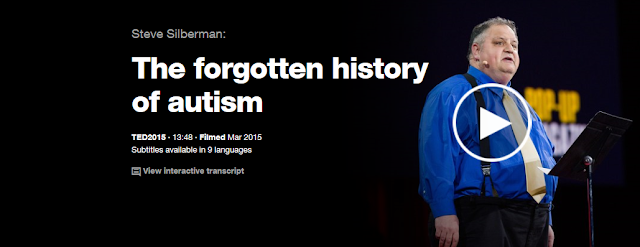Steve Silberman: the forgotten history of autism
time: 9:05
date: Thursday the 23/7/15
This video is about the forgotten history about autism and
the different papers and ideas on what autism is, how many people are affected,
how it happens and the different ways we can cure it (Some of these things we
are still trying to find out). The video talks about the psychiatrists and scientists
trying to prove their theories without any real evidence. It tells us that most other scientists were
scared to even think about what’s going on in the mind of and autistic child or
adult. Though child psychiatrist Leo Kanner and psychologist Lorna
Wing and colleague Judith Gould were
trying to prove all the questions that people were asking out not trying to
find out. Steve Silberman talks about how Kanner published a paper about 11
patients that were supposedly autistic, playing in private worlds and ignoring
everybody around them, even their parents. They could be happy and amuse
themselves for hours by flapping their hands in front of their faces, though as
soon as things like their favorite toy was being moved from its usual position
they started panicking. Kanner was basing his progress in this discovery with patients
brought to his clinic, he speculated that autism is quite rare. In 1950 he was the
world’s leading authority on the subject, saying that he had only seen less
that than 150 true cases of this profound syndrome, he was even fielding referrals
as far away as South Africa. Some of his diagnoses were incredibly selective
and some of his theories didn’t pan out properly. For example; he discouraged
giving any diagnosis’s to children who have seizures. (Though now we know that
epilepsy plays a big part and is very common in autism. In the 1970’s other
psychiatrists and psychologists were trying to prove his theory if his theory
of autism was true or not and was as rare as he said it was. Lorna and Judith undertook
a study of autism prevalence in the general population. They went around they
suburb Camberwell in London and what they saw was that Kanner’s theory was way
to narrow, while the reality was much larger than Kanner expected. Silberman
ends the talk with a quote from Zosia Zaks an autistic woman stating "We
need all hands on deck to right the ship of humanity”.
One thing that was interesting was that it took
people over 50 years to work out what autism is, how it works and how it reacts
with different people.
The presenter, Steve Silberman made the talk
interesting by referring back to the past history and referring back to what
the psychologists and psychiatrist have said in the past. Not many people think
that history is interesting, though I was intrigued by this topic.
This site can be useful for kids education in a class for science learning about diseases and cures. It can also be useful to your education because of the amount of history and backlash that autism has gotten, this will let you think and look deeper into autism.
The challenges I faced with this program and the video was that I was in a classroom surrounded by 18 other people and didn't have headphones, so I had to quietly listen with my face nearly pressed against the computer screen, though I overcame the struggle because one of my classmates showed me that u could get subtitles and read the subtitles instead of listening to them talk. When I relised that dilemma solution it was much easier to work. The subtitles solution is a great alternative if (like me) you have more people around you.
Here is a screenshot of the transcript you can read.
I hope this post helped you realise the pros and cons about the forgotten history of autism and gave you some insight into what ted,com can help you achieve and in what different subjects at school you can use it for.
Thankyou for reading my blog, see you in the next one.
xx Izzi


No comments:
Post a Comment